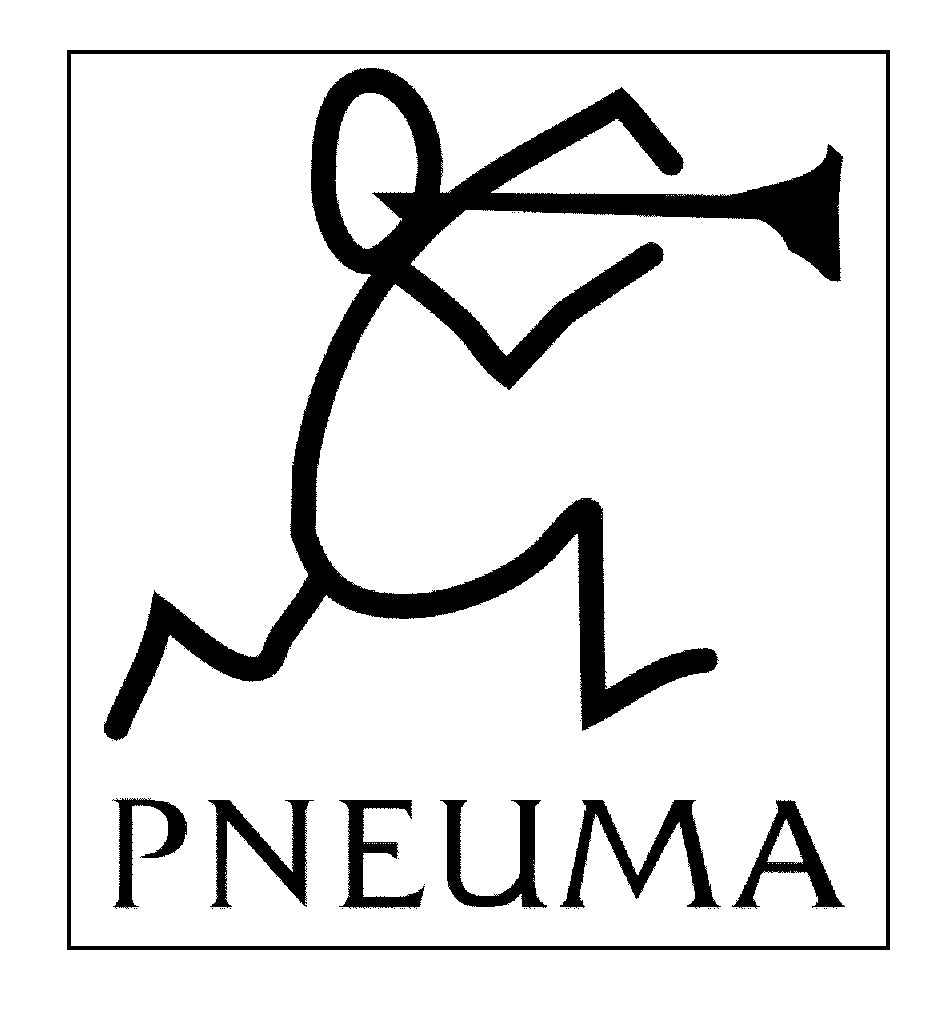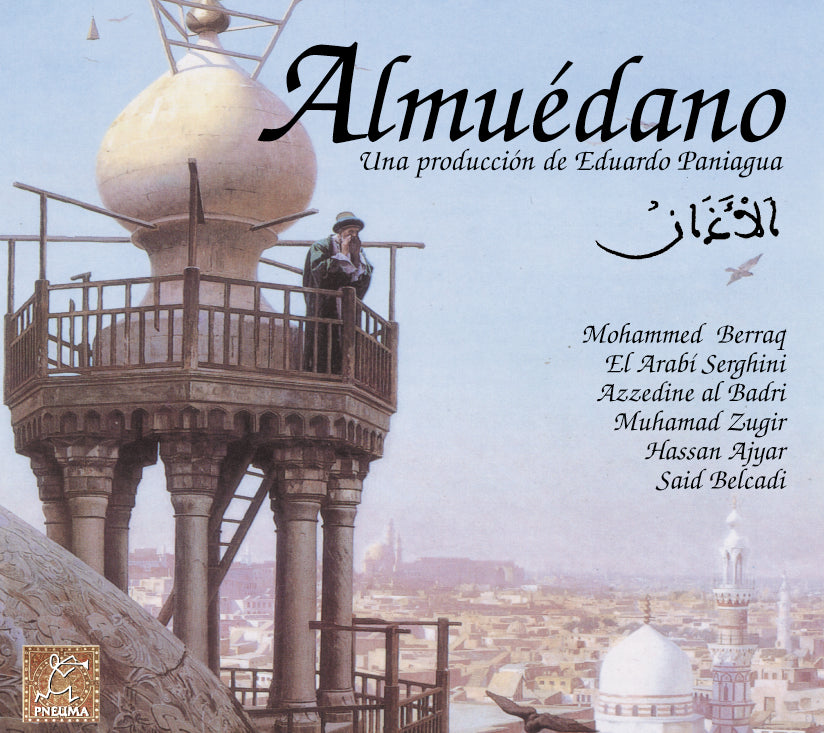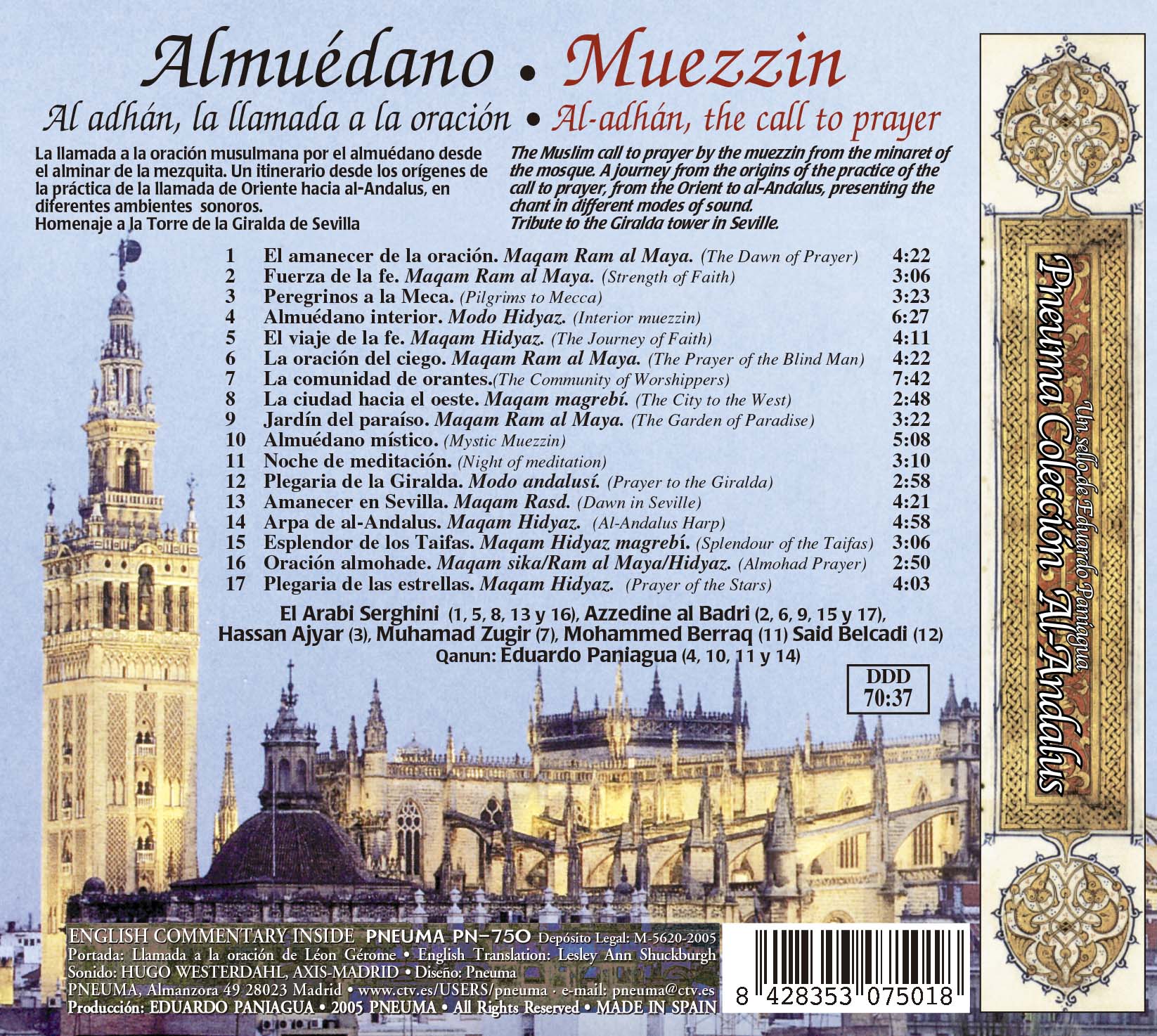pneumamusic
PN 750 ALMUÉDANO, LA LLAMADA A LA ORACIÓN
PN 750 ALMUÉDANO, LA LLAMADA A LA ORACIÓN
No se pudo cargar la disponibilidad de retiro
Índice
Índice
ALMUÉDANO • MUEZZIN
Al adhán, la llamada a la oración • Al-adhán, the call to prayer
La llamada a la oración musulmana por el almuédano desde el alminar de la mezquita. Un itinerario desde los orígenes de la práctica de la llamada de Oriente hacia al-Andalus, en diferentes ambientes sonoros.
Homenaje a la Torre de la Giralda de Sevilla
The Muslim call to prayer by the muezzin from the minaret of the mosque. A journey from the origins of the practice of the call to prayer, from the Orient to al-Andalus, presenting the chant in different modes of sound.
Tribute to the Giralda tower in Seville.
1 El amanecer de la oración. Maqam Ram al Maya. (The Dawn of Prayer) 4:22
2 Fuerza de la fe. Maqam Ram al Maya. (Strength of Faith) 3:06
3 Peregrinos a la Meca. (Pilgrims to Mecca) 3:23
4 Almuédano interior. Modo Hidyaz. (Interior muezzin) 6:27
5 El viaje de la fe. Maqam Hidyaz. (The Journey of Faith) 4:11
6 La oración del ciego. Maqam Ram al Maya. (The Prayer of the Blind Man)4:22
7 La comunidad de orantes.(The Community of Worshippers) 7:42
8 La ciudad hacia el oeste. Maqam magrebí. (The City to the West) 2:48
9 Jardín del paraíso. Maqam Ram al Maya. (The Garden of Paradise) 3:22
10 Almuédano místico. (Mystic Muezzin) 5:08
11 Noche de meditación. (Night of meditation) 3:10
12 Plegaria de la Giralda. Modo andalusí. (Prayer to the Giralda) 2:58
13 Amanecer en Sevilla. Maqam Rasd. (Dawn in Seville) 4:21
14 Arpa de al-Andalus. Maqam Hidyaz. (Al-Andalus Harp) 4:58
15 Esplendor de los Taifas. Maqam Hidyaz magrebí. (Splendour of the Taifas)3:06
16 Oración almohade. Maqam sika/Ram al Maya/Hidyaz. (Almohad Prayer) 2:50
17 Plegaria de las estrellas. Maqam Hidyaz. (Prayer of the Stars) 4:03
DDD 70:37
El Arabi Serghini (1, 5, 8, 13 y 16), Azzedine al Badri (2, 6, 9, 15 y 17),
Hassan Ajyar (3), Muhamad Zugir (7), Mohammed Berraq (11) Said Belcadi (12)
Qanun: Eduardo Paniagua (4, 10, 11 y 14)
ENGLISH COMMENTARY INSIDE
PNEUMA PN-75O Depósito Legal: M-5620-2005
Portada: Llamada a la oración de Léon Gérome • English Translation: Lesley Ann Shuckburgh
Sonido: HUGO WESTERDAHL, AXIS-MADRID • Diseño: Pneuma
Pneuma, Almanzora 49 28023 Madrid
Producción: EDUARDO PANIAGUA • 2005 PNEUMA • All Rights Reserved • MADE IN SPAIN
Almuédano
Una producción de Eduardo Paniagua
Mohammed Berraq
El Arabí Serghini
Azzedine al Badri
Muhamad Zugir
Hassan Ajyar
Said Belcadi
Almuédano
Al adhán, la llamada a la oración islámica
1 El amanecer de la oración
Medina. Homenaje a Bilal, primer almuédano.
Amanecer, desierto, grillos, oasis, hoguera.
Carácter tranquilo, íntimo, con somnolencia.
El Arabi Serghini. Maqam Ram al Maya
2 Fuerza de la fe
El Cairo. Junto al mar Rojo y el Mediterráneo.
La mañana, mar fuerte. Energía de la fuerza de la llamada a expandir la fe. Carácter suplicante y emotivo. Sonido del mar de Canyamel en Mallorca.
Azzedine al Badri. Maqam Ram al Maya
3 Peregrinos a la Meca
Meca. Canto de peregrinos de fondo a la llamada a la oración de hermosa melodía.
Hassan Ajyar. Cofradía Shushtarí de Omar Metioui. Añafil: David Mayoral y Eduardo Paniagua
4 Almuédano interior
Montaña. Meditación y oración sobre modo Hidyaz
Qanun: Eduardo Paniagua
5 El viaje de la fe
Desde un barco junto al puerto. Nostalgia del hogar.
El viaje de la fe y la oración.
Gaviotas y mar de Canyamel en Mallorca.
El Arabi Serghini. Maqam Hidyaz
6 La oración del ciego
Ciegos de Alepo el 2 de junio de 2004 al medio día, ambiente urbano en el patio de la mezquita Zaqariya Omeya de Alepo. Maestros de la medersa. Dua al Profeta con final de la Fatiha. Sonido del ambiente urbano de Esauira en el año 2003, Marruecos.
Azzedine al Badri. Maqam Ram al Maya
7 La comunidad de orantes
Al adhan coral y Dua comunitario, grabados (con autorización) el 1 de junio de 2004 en la sala de los cantores bajo el alminar de la mezquita Omeya de Damasco. Almuecín de Oriente. Maqam mohazin de la mezquita Omeya
Muhamad Zugir (jefe de la oración) y varios cantores
8 La ciudad hacia el oeste
Tánger-Algeciras. Ambiente urbano a la puesta del sol. Sonido de la calle de Alepo en 2004.
El Arabi Serghini. Maqam magrebí
9 Jardín del paraíso
Medina Zahara. Vergel andalusí en mezquita del palacio. Pájaros y arroyos al medio día.
Azzedine al Badri. Maqam Ram al Maya
10 Almuédano místico
Meditación en la noche
Qanun: Eduardo Paniagua
11 Noche de meditación
Córdoba. Hermosa y serena oración nocturna.
Homenaje al almuédano Berraq
Mohammed Berraq
12 Plegaria de la Giralda
Sevilla. Lágrimas por la Giralda almohade sobre una tormenta con truenos.
Homenaje a Ahmad ibn Básso, alarife de la Giralda, y al rey Alfonso X el Sabio, que prohibió su demolición.
Said Belcadi. Modo andalusí
13 Amanecer en Sevilla
Canto adormecido, confiado, sereno.
Canto de mirlos al alba en Aravaca, Madrid.
Mohammed El Arabi Serghini. Maqam Rasd
14 Arpa de al-Andalus
Toledo. Solo sobre maqam Hidyaz.
Qanun: Eduardo Paniagua
15 Esplendor de los Taifas
Zaragoza. Temor y peligro de la pérdida de la ciudad.
Azzedine al Badri. Maqam Hidyaz magrebí
16 Oración almohade
Almería. Intensa oración de corazón puro.
El Arabi Serghini. Maqam sika/Ram al Maya /Hidyaz
17 Plegaria de las estrellas
Murcia. Recogida noche estrellada, esperanza de luz. Sonido de grillos en Tánger.
Azzedine al Badri. Maqam Hidyaz
AL-ADHÁN, LA LLAMADA A LA ORACIÓN
Dios es más grande
Doy testimonio de que no hay divinidad sino Dios
Doy testimonio de que Muhammad es el Enviado de Dios
Venid a la oración
Acudid a la bienaventuranza
Dios es más grande
No hay divinidad sino Dios.
Descripción
Descripción
AL-ADHÁN, LA LLAMADA A LA ORACIÓN
Dios es más grande
Doy testimonio de que no hay divinidad sino Dios
Doy testimonio de que Muhammad es el Enviado de Dios
Venid a la oración
Acudid a la bienaventuranza
Dios es más grande
No hay divinidad sino Dios.
El texto de esta llamada a la oración se basa en la confesión de la fe (shaháda) que constituye el pilar fundamental de los cinco preceptos del Islám. Desde lo alto del alminar o minarete de la mezquita esta llamada a la oración se realiza cinco veces según las cinco preceptivas oraciones de cada día: la primera comienza antes de que salga el sol (fajr), la segunda cuando el sol está en su zenit (dhuhr), la tercera entre el zenit y el ocaso del sol, cuando la sombra dobla el tamaño del objeto (ásr), la cuarta a la hora de la puesta del sol (maghrib), y la quinta se realiza con la aparición de las primeras estrellas, entre una y dos horas después de la anterior (’ishá’).
Este CD recoge algunas de las múltiples formas de la llamada a la oración musulmana. Sobre un único texto, la melodía obedece en cada caso a una de las diversas escalas musicales (maqam) y a la expresividad emocional del cantor, el almuédano.
Hemos imaginado un itinerario desde los orígenes de la práctica de la llamada a la oración, introduciendo el canto en diferentes ambientes sonoros ligados a las mezquitas. Desde una hoguera en la noche del desierto de Oriente, pasando por las ciudades junto al mar, por las grandes capitales de la cultura musulmana y por las mezquitas rodeadas de los jardines de los palacios de al-Andalus.
Este trabajo quiere ser un reconocimiento a todos los seres humanos que rezan y en especial a los almuédanos que con su canto invitan a rezar.
También es un homenaje a la Giralda de Sevilla.
El alminar, arquitectura para la llamada a la oración
La costumbre de hacer la llamada a la oración de viva voz (adhan) por boca del muecín o almuédano indujo la necesidad de la creación del alminar, la torre de la mezquita.
Durante años se hizo la llamada desde el tejado de la mezquita, en contraste con el sistema de llamada cristiano oriental que consistía en golpear un madero, o el de los judíos, que para ciertas ceremonias utilizaban el sonido del shofar o cuerno de carnero.
El primer alminar se construyó en Basora en el año 665.
Inicialmente al alminar se construyó de planta cuadrada con un segundo cuerpo cilíndrico. En el siglo IX se edificaron en Samarra y El Cairo de planta helicoidal con la escalera al exterior. Posteriormente aparecen tipos de mezquita con dos alminares simétricos respecto al su pórtico, que en el tiempo de los mogoles y otomanos pasaron a ser cuatro, o seis en raras excepciones.
Las mezquitas del Magreb y de al-Andalus generalmente se construían con un solo alminar, aislado, esbelto, de planta cuadrada.
La Gran Mezquita de Sevilla fue comenzada en 1172 por el almohade Abu Yaqub Yusuf I. Su alminar, la famosa torre de la Giralda, hoy símbolo de la ciudad, fue comenzada a edificar en 1184 por el arquitecto Ahmad ibn Básso “príncipe de los alarifes” y terminada en 1198 bajo la dirección de Alí al-Gomarí. Está edificada con piedra y ladrillo y cuenta con una rampa interior en lugar de la escalera. Con sus esbeltos paneles de arcos entrecruzados en sus cuatro diferentes fachadas y con las cuatro bolas doradas de su coronación, obra del metalista siciliano Abú-l-Layt, causó estupor por el alarde constructivo de su altura. Hoy día tiene un remate arquitectónico renacentista al ser transformada en campanario de la catedral.
Eduardo Paniagua
LA LLAMADA PÚBLICA A LA PLEGARIA RITUAL
El Corán prescribe al fiel: “No ahueques la voz cuando reces, ni tampoco reduzcas tu soplo, sino permanece en el justo medio, entre ambos”.
«Aún me parece oír la voz serena de René Guénon citando la frase en árabe. Estábamos en el Cairo y se trataba de la llamada a la plegaria ritual. El grito había salido demasiado vibrante desde el minarete, demasiado patético para que pudiera durar. En efecto, pronto el sonido decayó hasta convertirse en una serie de gorgoritos convulsos. Guénon me mencionaba las mezquitas en las que había escuchado las invocaciones más firmes. “No ahueques la voz” se refiere a las repudiables falsas embriagueces de una pretendida exaltación mística; pero igualmente rechazables son los “murmullos”, es decir, esos desmayos que vuelven al individuo sobre sí mismo, exponiéndole a las complacencias de los estados del alma egoica.
“No se trata, -repetía Guénon-, de ser persuasivo, pero tampoco pretendidamente fascinador, sino simplemente de decir LO QUE ES”. Decir “lo que Es”, sin mezclar en ello la voluntad ni la habilidad personales, sin intromisión de cuerpo extraño alguno.»
Najm ad-Dîn Bammate (1922-1985)
Responsable del proyecto de la UNESCO “Oriente -Occidente”
El adhân, la llamada pública a la plegaria ritual o salât, es, como la misma plegaria, un rito, es decir, una prescripción operativa de origen no humano, inspirada por Dios. Según la Tradición, dos de los Compañeros del Profeta Muhammad soñaron al mismo tiempo la fórmula del adhân y la forma en la que tenía que ser llevado a cabo, siendo Bilál, un antiguo esclavo negro liberado, el Compañero elegido por el Enviado del Cielo para desempeñar por vez primera la nueva función de anunciador del momento de la plegaria.
Dice Rumí en su Mathnawí (libro I, poema 1985):
“El Espíritu es perfección y su llamada es perfección.
El Elegido (Muhammad) solía decir: “¡Consuélanos, Bilál!”
¡Oh Bilál, eleva tu voz melodiosa
desde ese aliento que insuflé en tu corazón,
desde ese aliento por el cual Adán quedó mudo de asombro
y las inteligencias de los habitantes del Cielo
quedaron reducidas a nada!”.
El momento en el que el almuédano (en árabe: mu’adhdhin) eleva su voz para proclamar la Unidad de Dios y llamar a los fieles a la plegaria es, según la Tradición, un momento bendito en el que las puertas del Cielo se abren, y en el que la Misericordia Divina no deja sin respuesta las súplicas que Le son dirigidas.
El lugar de la mezquita desde el que cinco veces al día se lleva a cabo el adhân, es el “minarete” o “alminar”, en árabe manâra (lit. “lugar desde el que se ilumina”, “torre de señales”) o mi’dhana (lit. “lugar desde el que se hace el adhân”), siendo obligatoria la llamada sólo en las mezquitas en las que se realiza la plegaria ritual en congregación.
A lo largo y ancho del mundo islámico, la variedad estilística en el adhân depende del “espíritu” de la escuela jurídica de cada lugar. En Marruecos o Argelia, por ejemplo, se suele realizar de forma sobria, casi monótona, conforme al temperamento de la escuela malikî, que es la mayoritaria en esos países. En el Oriente Medio, donde son otras escuelas, como la hanafî, las que prevalecen, se utilizan estilos más “floreados” y brillantes, musicalmente hablando.
Tradicionalmente, se considera que existen tres formas de efectuar el adhân, denominadas respectivamente “llamada en quince frases”, “llamada en diecinueve frases” y “llamada en trece frases”, siendo la primera forma la más habitual, consistiendo en las siguientes fórmulas:
Dios es más grande (4 veces)
Doy testimonio de que no hay divinidad sino Dios (2 veces)
Doy testimonio de que Muhammad es el Enviado de Dios (2 veces)
Acudid a la plegaria (2 veces).
Acudid a la Dicha (2 veces)
Dios es más grande (2 veces)
No hay divinidad sino Dios
En la plegaria del alba, tras la invitación “acudid a la dicha” se añade “la plegaria es mejor que el sueño” (2 veces).
Tradicionalmente, el almuédano, que no debe cobrar ningún salario por el desempeño de su función, en el momento de llamar a los fieles deberá estar en estado de pureza ritual, de pie en dirección a la Meca, y efectuar la llamada con las manos sobre los oídos, girándose de derecha a izquierda. Pero, en cualquier caso, la única condición indispensable es la articulación correcta de las frases que componen la llamada ritual, de forma que sean perfectamente comprensibles para la totalidad de los fieles que puedan escucharla.
El sufí Ibn ‘Arabî advierte sobre el hecho de que, en su conjunto, las frases que componen el adhân son todas ellas, exceptuando las propiamente “de llamada” (“acudid a la plegaria, acudid a la Dicha”), fórmulas de dhikr (lit. “recuerdo” de Dios, mediante la repetición de frases o nombres sagrados). Así pues, además de una convocatoria dirigida a la comunidad de los creyentes para que cumplan con sus deberes rituales hacia su Señor, se trata de una “llamada de atención” que, cinco veces al día, irrumpirá vibrante en el estado de negligencia, de distracción y de olvido de la presencia de Dios en que se encuentra el común de los hombres, para recordarles que “Dios es más grande” que cualquier actividad, ocupación o pensamiento en el que se encuentren sumergidos en ese momento, por muy importante que parezca. En definitiva, una llamada al alma, prisionera en este mundo, un recuerdo de su Origen y de su lugar de Retorno, “lugar” al que el creyente “ascenderá” mediante el rito de la salât, la plegaria ritual, que es, según las palabras del Enviado, “el mi‘râj (la “ascensión”) del creyente”.
Andrés R. Guijarro
MUEZZIN
Al-adhán, the call to prayer
1 The Dawn of Prayer
Medina. A tribute to Bilál, the first muezzin.
Dawn, desert, crickets, oasis, camp fire.
Calm, intimate, sleepy.
El Arabi Serghini. Maqam Ram al Maya
2 Strength of Faith
Cairo. Near the Red sea and the Mediterranean.
Morning, rough sea. The force of the energy arising from the call to spread the faith. Imploring and emotive. Sound of the sea at Canyamel in Mallorca.
Azzedine al Badri. Maqam Ram al Maya
3 Pilgrims to Mecca
Mecca. Pilgrims chanting in the background to the call to prayer sung with a beautiful melody.
Hassan Ajyar. Al Shushtarí brotherhood of Omar Metioui. Natural trumpet: David Mayoral and Eduardo Paniagua
4 Interior muezzin
Mountains. Meditation and prayer in the Hidyaz mode.
Qanun: Eduardo Paniagua
5 The Journey of Faith
From a boat near the harbour. Nostalgia for home.
The journey of faith and prayer.
Seagulls and sea at Canyamel in Mallorca.
El Arabi Serghini. Maqam Hidyaz.
6 The Prayer of the Blind Man.
The blind in Aleppo on 2 June 2004 at midday, urban atmosphere in the patio of the Zaqariya Omayyad mosque in Aleppo. Masters of the school. Dua (invocation) to the Prophet finishing with words from the opening chapter in the Quran. Street noise in Esauira 2003, Morocco.
Azzedine al Badri. Maqam Ram al Maya
7 The Community of Worshippers
Choral version of the adhan,(call to prayer) and community Dua (invocation), authorised recording from 1st June 2004 in the chanters’ hall in the minaret of the Damascus Omayyad mosque. Muezzin from the Orient. Maqam mohazin of the Omayyad mosque.
Muhammad Zugir (head of prayer) and chanters.
8 The City to the West
Tangier-Algeciras, town atmosphere at sunset.
Street noise from Aleppo 2004.
El Arabi Serghini. Maqam magrebí
9 The Garden of Paradise
Zahara medina. An Andalusian orchard in the palace mosque. Birds and streams at midday.
Azzedine al Badri. Maqam Ram al Maya
10 Mystic Muezzin
Meditation at night.
Qanun: Eduardo Paniagua
11 Night of meditation
Cordoba. Beautiful and serene nocturnal prayer.
Tribute to Berraq the muezzin.
Mohammed Berraq
12 Prayer to the Giralda
Seville. Tears for the Almohad Giralda tower in a thunderstorm.
A tribute to Ahmad ibn Básso, master builder of the Giralda, and King Alfonso X the Wise, who prevented its demolition.
Said Belcadi. Andalusí mode.
13 Dawn in Seville
Sleepy chant, confident, serene.
Sound of blackbirds at dawn in Aravaca, Madrid.
Mohammed El Arabi Serghini. Maqam Rasd
14 Al-Andalus Harp
Toledo. A solo based on the Hidyaz maqam.
Qanun: Eduardo Paniagua
15 Splendour of the Taifas
Zaragoza. Intense fear and the threat of losing the city.
Azzedine al Badri. Maqam Hidyaz magrebí.
16 Almohad Prayer
Almeria. Intense prayer from a pure heart.
El Arabi Serghini. Maqam sika/Ram al Maya /Hidyaz
17 Prayer of the Stars
Murcia. Quiet starry night, hope of light.
Sound of crickets in Tangier.
Azzedine al Badri. Maqam Hidyaz
AL-ADHÁN, THE CALL TO PRAYER
Allah is Greatest
I bear witness that there is no god but Allah
I bear witness that Muhammad is the Messenger of Allah
Hasten to the Prayer
Hasten to your prosperity
Allah is Greatest
There is no god but Allah.
This call to prayer is based on the confession of faith (shaháda), the cornerstone of the five Pillars of Islam. From the top of the minaret the call to prayer is chanted five times in accordance with the five preceptive prayers of each day: the first starts before dawn (fajr), the second when the sun is at its highest (dhuhr), the third between high noon and when the sun begins to set, when the shadows are twice as long (ásr), the fourth at sunset (maghrib) and the fifth when the first stars appear, between one and two hours after the previous one (‘ishá’).
This CD features a selection of the many forms of the Muslim call to prayer. The words are always the same but on each track the melody follows one of the many musical scales (maqam) and reflects the emotional expression of the chanter, the muezzin.
We have created an imaginary itinerary starting with the origins of the practice of the call to prayer, presenting the chant against different backgrounds of sound linked to the mosques. From a camp fire in the desert night in the Orient, to the cities by the sea and the great capitals of Muslim culture and the mosques surrounded by gardens in the palaces of al-Andalus.
This CD is a tribute to all those who pray and especially to the muezzins who call to prayer with their chant.
It is also a tribute to the Giralda tower in Seville.
The minaret, architecture for the call to prayer
The custom of the call to prayer viva voce (adhan) through the mouth of the muezzin led to a need for the minaret, the mosque tower.
For many years the call was made from the roof of the mosque, just as the oriental Christians struck a block of wood and the Jews sounded the shofar, the ram’s horn.
The first minaret was built in Basra in the year 665.
Initially, the minaret was square with a second cylindrical storey. In the 9th century the spiral minarets at Samarra and Cairo were built, with staircases winding round the outside of the walls. Later, mosques were built with two minarets symmetrical to the portico, or even four or occasionally six at the time of the Moguls and Ottomans.
The mosques of the Maghreb and al-Andalus were generally built with one tall and narrow, freestanding, square minaret.
The Great Mosque in Seville was begun in 1172 by the Almohad Abu Yaqub Yusuf I. Its minaret, the famous Giralda tower, today the symbol of the city, was begun in 1184 by the architect Ahmad ibn Básso “prince of the master builders” and finished in 1198 under the orders of Alí al-Gomarí. It is built of stone and brick and has a ramp inside instead of stairs. People were amazed by its height that in itself was a feat of construction, and its fine panels of intersecting arches on each of its four façades. The four golden spheres on the top were work of a Sicilian metal worker Abú-I-Layt. A renaissance addition converted the Giralda into the cathedral bell tower that it is today.
Eduardo Paniagua
THE PUBLIC CALL TO THE RITUAL PRAYER
The Quran tells the faithful “And thou be not loud voiced in thy worship nor yet silent therein, but follow a way between”
«I can still hear René Guénon’s serene voice quoting the phrase in Arabic. We were in Cairo and he was talking about the call to prayer. The call had come out too vibrantly from the minaret, too pathetic to be able to last. And so it was, soon the sound fell into a series of convulsive gurgles. Guénon told me where the mosques in which he had heard the firmest invocations were. “And thou be not loud voiced in thy worship” refers to the dismissible false raptures of an alleged mystic exaltation: but equally unacceptable are the “murmurs” that is, that listlessness that overcomes the individual, leading him to indulge in the states of the selfish soul.
“It is not a question, - repeated Guénon-, of being persuasive, but neither should it be pretentiously fascinating, but simply say IT”. Say “It”, without mixing personal wishes or abilities, without the intromission of any kind of extraneous body.»
Najm ad-Dîn Bammate (1922-1985)
Leader of the UNESCO “East-West” project.
The adhân, the public call to the ritual prayer or salât, is, like the prayer itself, a ritual, that is to say, an operative prescription of non-human origin, inspired by God. According to Tradition, two of the Prophet Muhammad’s companions had a simultaneous dream in which they visualised the formula of the adhân and the way it should be delivered. Bilál, an old liberated Negro slave, was the Companion chosen by the Messenger of Heaven to be the first to announce the time of prayer.
According to Rumî in his Mathnawí (book I, poem 1985):
“The Spirit is perfection and its call is perfection
The Chosen one (Muhammad) used to say,
“Comfort us, Bilál”
Oh Bilál, raise your melodious voice from the breath that I breathed into your heart,
From that breath that made
Adam dumb with amazement
and reduced the intellects
of the inhabitants of Heaven to nothing!”
When the Muezzin (in Arabic: mu’adhdin) raises his voice to proclaim the Unity of God and call the faithful to prayer, it is a blessed moment according to Tradition, when the gates of Heaven open, and the Divine Mercy leaves no prayer unanswered.
The part of the mosque from which the adhân is pronounced five times a day, is the minaret, in Arabic manara (lit. “place from where illumination comes” “tower of signs”) or midhana (lit. place from which the adhân is pronounced”), the call being obligatory only in the mosques in which the ritual prayer is practised in congregation.
The length and breadth of the Islamic world, the style of the adhân depends on the “spirit” of the school of religious law in each place. In Morocco or Algeria, for example, it is usually sober, almost monotonous, as is the temperament of the maliki school, which is predominant in these countries. In the Middle East, where other schools prevail, such as the hanafi, more “flowery” and brilliant musical styles are used.
Traditionally, there are considered to be three ways of delivering the adhân, called respectively “call in fifteen phrases”, “call in nineteen phrases” and “call in thirteen phrases” the first form being the most usual consisting of the following formulae:
Allah is Greatest (four times)
I bear witness that there is no god but Allah (twice)
I bear witness that Muhammad is the Messenger of Allah (twice)
Hasten to the Prayer (twice)
Hasten to your prosperity (twice)
Allah is Greatest (twice)
There is no god but Allah.
In the prayer at sunrise, after the invitation “hasten to real success” “prayer is better than sleep” is added twice.
Tradition also stipulates that the muezzin, who must not earn a wage for this job, should be in a state of ritual purity when he calls the faithful. He should be standing facing Mecca, and make the call with his hands over his ears, turning from right to left. But, in any case, the only condition which is indispensable is the correct articulation of the phrases that make up the ritual call, so that the words are perfectly clear for all the faithful who hear the call.
The Sufi Ibn ‘Arabî points out that in general, the phrases in the adhân are dhikr formulae (lit. “remembrance” of God, through of the repetition of holy phrases or names). With the exception that is, of the ones that actually “call” (“Hasten to prayer, Hasten to real success”).
As well as a call to the community of believers to fulfil their ritual obligations to their Lord, the adhân is a “call to attention” that, five times a day, vibrantly interrupts the state of negligence, distraction and forgetfulness of the presence of God in which most men find themselves, to remind them that “God is greater” than any activity, occupation or thought in which they are absorbed at that moment, however important it may seem. A call to the soul, prisoner in this world, a reminder of our Origins and place of Return, the “place” to which the believer will “ascend” through the ritual of the salât, the ritual prayer, which is, according to the words of the Messenger, “the mi’râj (the ascension) of the believer”.
Andrés R. Guijarro
Compartir
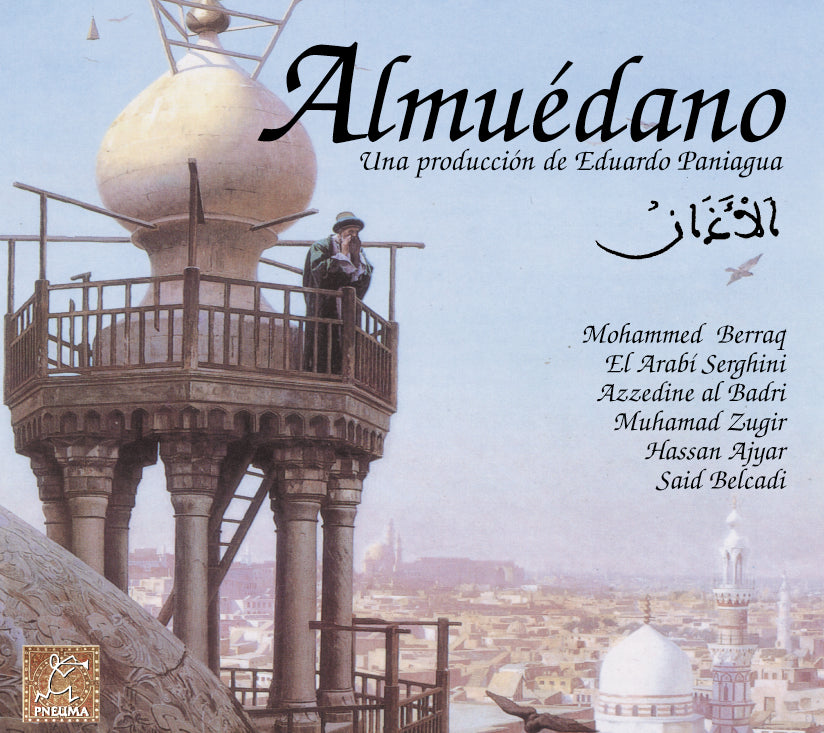
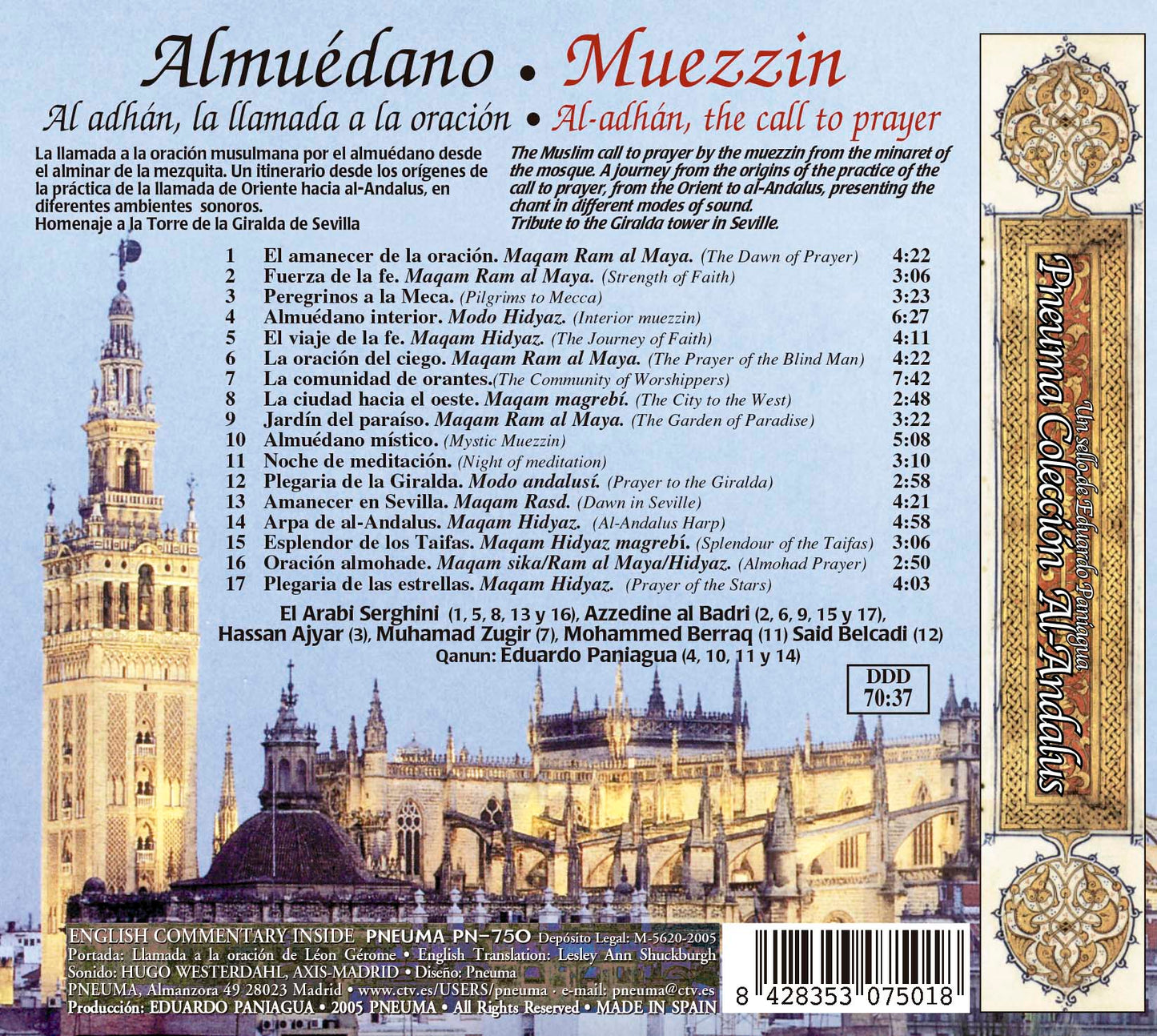
-
Envío gratis en pedidos mayores a 50 €.
Entrega en 5-7 días laborables para pedidos en España, en el caso de envíos fuera de España el tiempo de envío podría ser algo mayor.
-
Todo el trabajo de Pneuma Music se ha realizado en España.
Música medieval española inédita hasta el momento. Sus discos, con formato Digipack de cubierta de cartón y libreto interior (bilingüe + idioma original), quieren acercarse a una obra de arte total.
